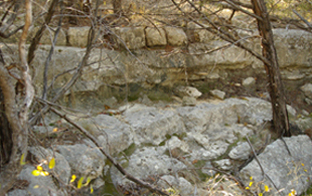
The surface geology of the Browning Ranch is comprised mostly of carbonate rocks deposited during the Cretaceous period (66 to 144 million years ago) when the climate was tropical and a shallow inland sea covered much of central North America. These layers of calcareous sediment solidified as limestone and dolomite, the major geological formations of the Edwards Plateau.

Epochs of erosion reveals the stair-step topography produced by the underlying Glen Rose limestone.
The topography of the Browning Ranch is typical of other parts of the Edwards Plateau where the raised highlands have been eroded by many seasonal spring-fed creeks into a rough, hilly landscape of hard, dry upland plateaus dissected by stream canyons, flowing into Honeycut Hollow Creek’s shallow valley. The hillsides of the upland areas are characterized by a stair-step topography created by the uneven erosion of soft and hard limestone layers in the Glen Rose limestone formation.
